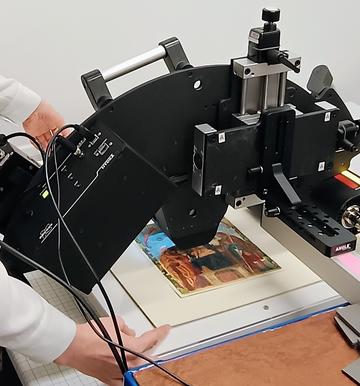RUSKIN'S PAINTING MATERIALS
The Ashmolean houses the teaching collection of 1,470 works of art assembled by John Ruskin for his Drawing School in Oxford founded in 1871. The collection consists of watercolours, drawings, prints and photographs of works of art, architecture and natural history made by Ruskin himself and commissioned from his contemporaries including J.M.W. Turner, Burne-Jones and William Henry Hunt. Ruskin assembled his collection specifically for his students to copy in order to master the techniques of outline, shading and colour.
About the research project
This four-year interdisciplinary research project, funded by the Leverhulme Trust, explores the impact of the 19th-century Industrial Revolution on painting materials in Ruskin’s teaching collection. The project is the first of its kind to conduct a comprehensive characterisation of watercolour pigments used by Ruskin and contemporary artists in commissioned works.
Utilising the Museum’s new suite of cutting-edge non-invasive analytical techniques generously funded through the AHRC Capability for Collections Fund, including macro-X-ray fluorescence (MA-XRF), X-ray diffraction (XRD), infrared reflectography (IRR), high resolution 3D digital microscopy and reflectance transformation imaging (RTI) combined with fiber optics reflectance spectroscopy (FORS) from Durham University and Atmospheric Solids Analysis Probe mass spectroscopy (ASAP-MS) at the Chemistry Research Laboratory, the project aims to address questions surrounding the adoption of new synthetic materials, application techniques, dating, provenancing materials, deterioration and conservation.
The project is being conducted by a full-time researcher with oversight and support from the project team comprising of specialists in conservation science, paper conservation, chemical analysis, art curation and collections management.
The first phase of the project delivered by Dr Ghigo focussed on implementing analytical equipment and protocols; assessing the efficacy of ASAP-MS on watercolours; artist’s choice and colour durability; and representation of colours of the past. Dr Kemp joined the project team in October 2023 and is currently exploring the application of surface imaging techniques combined with compositional analysis to the study of painting materials and techniques of artists throughout the collection.

Keyence VHX-7000 digital microscope image of Peach and Grapes, circa 1845, William Henry Hunt, WA.RS.ED.213

Bruker Hydra XRD/XRF
Project funders
Leverhulme Trust Project Grant (RPG-2021-430)

Project dates
1 April 2022 – 31 March 2026
Project team
Principal Investigator: Dr Kelly Domoney, Conservation Manager - Preventive, Science and Technical
Co-Investigator: Daniel Bone, Head of Conservation
Postdoctoral Research Assistant: Dr Victoria Kemp (from Oct 2023)
Postdoctoral Research Assistant: Dr Tea Ghigo, (Apr 2022 - Sep 2023)
Colin Harrison, Senior Curator of European Art
Matthew Winterbottom, Assistant Keeper, Curator of Sculpture and Decorative Arts
Alexandra Greathead, Conservation Manager - Works of Art on Paper
Dr Caroline Palmer, Print Room Manager
Katherine Wodehouse, Print Room Manager
Dr John Walsby-Tickle, Chemistry Research Laboratory
Professor Andrew Beeby, Durham University




